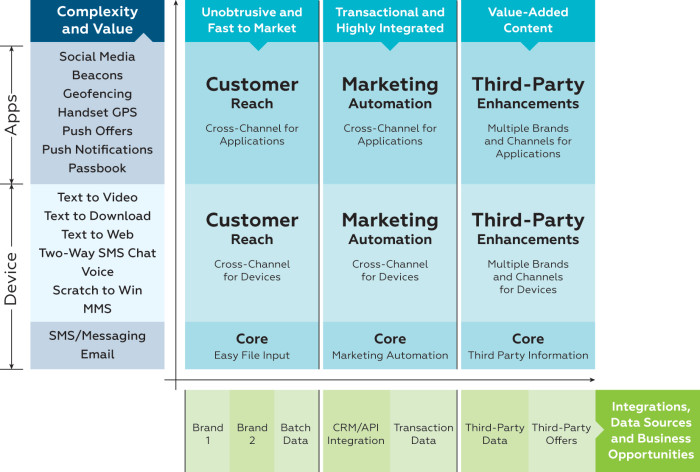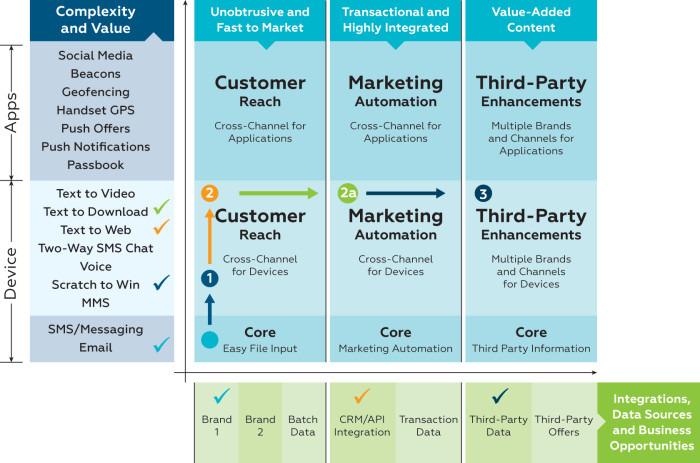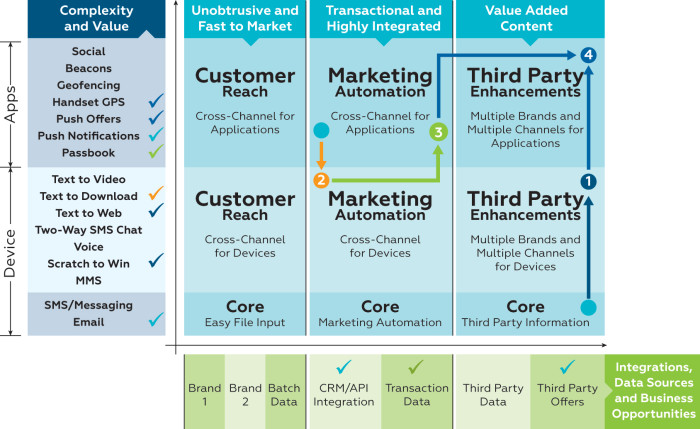Mobile’s seismic effect
We can’t underestimate the effect of mobile in reshaping our approach to marketing and customer engagement. Its seismic impact is fundamentally changing our understanding of what’s been known as the digital channel.
At this point, there is no longer such thing as a digital channel. Rather, digital is simply another term for a technology format while mobile is the channel we use to manage digital interactions.
With a dizzying collection of technologies and options to choose from, many companies aren’t sure where to begin their mobile efforts or even how to systematically consider the options. Many companies often fail to think through what layers of mobile touch points are needed at which stages of the customer journey in order to drive the desired actions from consumers.
Connecting the disconnected
Too often, mobile touch points exist independently, disconnected from one another and other digital customer engagement tools – such as automated email marketing – that are commonly used in a path to action.
To help companies understand how their customers are using mobile and adjust the sequence of the mobile journey accordingly, Syniverse has devised a Mobile Engagement Maturity Model. The model helps companies guide decisions around the best mobile investments and returns based on its particular objectives.
The Mobile Engagement Maturity Model
The Mobile Engagement Maturity Model maps business and technical complexity on a two-dimensional grid. The vertical axis or “y axis” represents customer technology options and the horizontal or “x axis” depicts increasingly complex business collaboration.

Figure 1 – The Mobile Engagement Maturity Model
Moving up from the bottom of the model’s vertical axis, customer engagement becomes richer as a company leverages two-way interactions like text-to-Web and two-way SMS chat. Next, there are more complex solutions that leverage additions to the device operating system like light apps (e.g., Passbook), native applications, location and social.
On the horizontal axis, value and complexity increase as brands integrate with enterprise systems to provide marketing automation. This axis begins with the capability to upload data files, moves to marketing automation capabilities that enable a brand to move past promotional messages (such as coupons) to transactional messages (like order receipts or shipping notifications) to increase the number of potential touch points that deepen the relationship with the customer.
The final section of the horizontal or “X Axis” is partnering with third-party companies to enrich content, improve targeting and produce compelling offers.
How to use the model
Using the model is simple. A company begins by identifying the digital tools and data sources the company is currently using for mobile engagement. It’s helpful to use the model as a checklist to make sure nothing is missed in the first step.
Next, the company marks the assets on the horizontal and vertical axis. A company may have a couple of starting points to reflect disconnected programs. In the subsequent steps, the company will mark desired capabilities and then finally group the desired capabilities into groups. These groups are then planned as unique projects.
Outlined below are two examples of brands in different stages of the maturity model:
New to Mobile
Brand X is new to mobile. It currently uses email to send promotional messages and a newsletter to customers. However, it doesn’t know how much this engagement is changing customer behavior. Brand X is eager to embrace mobile, but it doesn’t know where to begin.

Figure 2 – New to Mobile Model Example
The brand should start by building a database of mobile phone numbers from customers who’ve opted-in to receive messages and promotions on their mobile devices. Brand X can add mobile pathways, like text messaging and text-to-Web, to its existing communications by integrating APIs, allowing it to share what was previously email-only content via mobile as well.
With this foundation in place, Brand X can explore collaborating with third parties and other brands to share customer data and launch mutually beneficial cross-promotions. These partnerships will add value to Brand X and encourage ongoing engagement with its customers.
Exploring Mobile
Like many companies, Brand Z has embraced mobile’s potential. Its marketing and customer loyalty teams developed a native smartphone app to deliver offers and information (including location-based promotions) to customers.

Figure 3 – Email and Native App Model Example
Twenty percent of Brand Z’s customers initially downloaded the app, but since the launch, usage has fallen to less than 5 percent. This limited usage makes it difficult for Brand Z to justify the expense of maintaining and refreshing the app.
Brand Z also runs a sophisticated automated email marketing program that sends daily personalized promotional and transactional messages and partner offers to its customers.
The challenge for Brand Z is to increase its consumer engagement on its forgotten mobile app and its existing automated email program. To do so, it can add mobile functionality to its automated marketing through messaging-based channels like text-to-Web. This could be as simple as sending a shortened URL link via text message taking customers to Brand Z’s Web page. There, customers could interact with the brand by playing a game, scheduling an appointment, entering a competition or downloading a coupon.
More than ever, mobile is crucial to brands and organizations as a means to drive ongoing consumer engagement, spur sales, boost loyalty and add value to customer relationships. Once a strategy is defined, the brand can decide which mobile channels and tools to invest in to drive the desired action.
The aim is not just an immediate improvement in customer engagement and loyalty, but also to future-proof a company’s mobile engagement strategy as customers become ever more mobile-savvy and demanding for mobile services.






